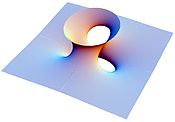Mean curvature
In mathematics, the mean curvature H{displaystyle H}

The concept was used by Sophie Germain in her work on elasticity theory.[1][2]Jean Baptiste Marie Meusnier used it in 1776, in his studies of minimal surfaces. It is important in the analysis of minimal surfaces, which have mean curvature zero, and in the analysis of physical interfaces between fluids (such as soap films) which, for example, have constant mean curvature in static flows, by the Young-Laplace equation.
Contents
1 Definition
1.1 Surfaces in 3D space
1.2 Implicit form of mean curvature
2 Mean curvature in fluid mechanics
3 Minimal surfaces
3.1 CMC surfaces
4 See also
5 Notes
6 References
Definition
Let p{displaystyle p}








The mean curvature at p∈S{displaystyle pin S}

H=12π∫02πκ(θ)dθ{displaystyle H={frac {1}{2pi }}int _{0}^{2pi }kappa (theta );dtheta }.
By applying Euler's theorem, this is equal to the average of the principal curvatures (Spivak 1999, Volume 3, Chapter 2):
- H=12(κ1+κ2).{displaystyle H={1 over 2}(kappa _{1}+kappa _{2}).}
More generally (Spivak 1999, Volume 4, Chapter 7), for a hypersurface T{displaystyle T}
- H=1n∑i=1nκi.{displaystyle H={frac {1}{n}}sum _{i=1}^{n}kappa _{i}.}
More abstractly, the mean curvature is the trace of the second fundamental form divided by n (or equivalently, the shape operator).
Additionally, the mean curvature H{displaystyle H}

- Hn→=gij∇i∇jX,{displaystyle H{vec {n}}=g^{ij}nabla _{i}nabla _{j}X,}
using the Gauss-Weingarten relations, where X(x){displaystyle X(x)}


A surface is a minimal surface if and only if the mean curvature is zero. Furthermore, a surface which evolves under the mean curvature of the surface S{displaystyle S}
The sphere is the only embedded surface of constant positive mean curvature without boundary or singularities. However, the result is not true when the condition "embedded surface" is weakened to "immersed surface".[3]
Surfaces in 3D space
For a surface defined in 3D space, the mean curvature is related to a unit normal of the surface:
- 2H=−∇⋅n^{displaystyle 2H=-nabla cdot {hat {n}}}
where the normal chosen affects the sign of the curvature. The sign of the curvature depends on the choice of normal: the curvature is positive if the surface curves "towards" the normal. The formula above holds for surfaces in 3D space defined in any manner, as long as the divergence of the unit normal may be calculated. Mean Curvature may also be calculated
- 2H=Trace((II)(I−1)){displaystyle 2H={text{Trace}}((II)(I^{-1}))}
where I and II denote first and second quadratic form matrices, respectively.
For the special case of a surface defined as a function of two coordinates, e.g. z=S(x,y){displaystyle z=S(x,y)}
- 2H=−∇⋅(∇(z−S)|∇(z−S)|)=∇⋅(∇S−∇z1+|∇S|2)=(1+(∂S∂x)2)∂2S∂y2−2∂S∂x∂S∂y∂2S∂x∂y+(1+(∂S∂y)2)∂2S∂x2(1+(∂S∂x)2+(∂S∂y)2)3/2.{displaystyle {begin{aligned}2H&=-nabla cdot left({frac {nabla (z-S)}{|nabla (z-S)|}}right)\&=nabla cdot left({frac {nabla S-nabla z}{sqrt {1+|nabla S|^{2}}}}right)\&={frac {left(1+left({frac {partial S}{partial x}}right)^{2}right){frac {partial ^{2}S}{partial y^{2}}}-2{frac {partial S}{partial x}}{frac {partial S}{partial y}}{frac {partial ^{2}S}{partial xpartial y}}+left(1+left({frac {partial S}{partial y}}right)^{2}right){frac {partial ^{2}S}{partial x^{2}}}}{left(1+left({frac {partial S}{partial x}}right)^{2}+left({frac {partial S}{partial y}}right)^{2}right)^{3/2}}}.end{aligned}}}
In particular at a point where ∇S=0{displaystyle nabla S=0}

If the surface is additionally known to be axisymmetric with z=S(r){displaystyle z=S(r)}
- 2H=∂2S∂r2(1+(∂S∂r)2)3/2+∂S∂r1r(1+(∂S∂r)2)1/2,{displaystyle 2H={frac {frac {partial ^{2}S}{partial r^{2}}}{left(1+left({frac {partial S}{partial r}}right)^{2}right)^{3/2}}}+{frac {partial S}{partial r}}{frac {1}{rleft(1+left({frac {partial S}{partial r}}right)^{2}right)^{1/2}}},}
where ∂S∂r1r{displaystyle {frac {partial S}{partial r}}{frac {1}{r}}}

Implicit form of mean curvature
The mean curvature of a surface specified by an implicit equation F(x,y,z)=0{displaystyle F(x,y,z)=0}

- Hess(F)=(∂2F∂x2∂2F∂x∂y∂2F∂x∂z∂2F∂y∂x∂2F∂y2∂2F∂y∂z∂2F∂z∂x∂2F∂z∂y∂2F∂z2).{displaystyle textstyle {mbox{Hess}}(F)={begin{pmatrix}{frac {partial ^{2}F}{partial x^{2}}}&{frac {partial ^{2}F}{partial xpartial y}}&{frac {partial ^{2}F}{partial xpartial z}}\{frac {partial ^{2}F}{partial ypartial x}}&{frac {partial ^{2}F}{partial y^{2}}}&{frac {partial ^{2}F}{partial ypartial z}}\{frac {partial ^{2}F}{partial zpartial x}}&{frac {partial ^{2}F}{partial zpartial y}}&{frac {partial ^{2}F}{partial z^{2}}}end{pmatrix}}.}
The mean curvature is given by:[4][5]
- H=∇F Hess(F) ∇FT−|∇F|2Trace(Hess(F))2|∇F|3{displaystyle H={frac {nabla F {mbox{Hess}}(F) nabla F^{mathsf {T}}-|nabla F|^{2},{text{Trace}}({mbox{Hess}}(F))}{2|nabla F|^{3}}}}
Another form is as the divergence of the unit normal. A unit normal is given by ∇F|∇F|{displaystyle {frac {nabla F}{|nabla F|}}}
- H=−12∇⋅(∇F|∇F|).{displaystyle H=-{frac {1}{2}}nabla cdot left({frac {nabla F}{|nabla F|}}right).}
Mean curvature in fluid mechanics
An alternate definition is occasionally used in fluid mechanics to avoid factors of two:
Hf=(κ1+κ2){displaystyle H_{f}=(kappa _{1}+kappa _{2}),}.
This results in the pressure according to the Young-Laplace equation inside an equilibrium spherical droplet being surface tension times Hf{displaystyle H_{f}}
κ1=κ2=r−1{displaystyle kappa _{1}=kappa _{2}=r^{-1},}.
Minimal surfaces

A rendering of Costa's minimal surface.
A minimal surface is a surface which has zero mean curvature at all points. Classic examples include the catenoid, helicoid and Enneper surface. Recent discoveries include Costa's minimal surface and the Gyroid.
CMC surfaces
An extension of the idea of a minimal surface are surfaces of constant mean curvature. The surfaces of unit constant mean curvature in hyperbolic space are called Bryant surfaces.[6]
See also
- Gaussian curvature
- Mean curvature flow
- Inverse mean curvature flow
- First variation of area formula
- Stretched grid method
Notes
^ Marie-Louise Dubreil-Jacotin on Sophie Germain
^ Lodder, J. (2003). "Curvature in the Calculus Curriculum". The American Mathematical Monthly. 110 (7): 593–605. doi:10.2307/3647744. JSTOR 3647744..mw-parser-output cite.citation{font-style:inherit}.mw-parser-output .citation q{quotes:"""""""'""'"}.mw-parser-output .citation .cs1-lock-free a{background:url("//upload.wikimedia.org/wikipedia/commons/thumb/6/65/Lock-green.svg/9px-Lock-green.svg.png")no-repeat;background-position:right .1em center}.mw-parser-output .citation .cs1-lock-limited a,.mw-parser-output .citation .cs1-lock-registration a{background:url("//upload.wikimedia.org/wikipedia/commons/thumb/d/d6/Lock-gray-alt-2.svg/9px-Lock-gray-alt-2.svg.png")no-repeat;background-position:right .1em center}.mw-parser-output .citation .cs1-lock-subscription a{background:url("//upload.wikimedia.org/wikipedia/commons/thumb/a/aa/Lock-red-alt-2.svg/9px-Lock-red-alt-2.svg.png")no-repeat;background-position:right .1em center}.mw-parser-output .cs1-subscription,.mw-parser-output .cs1-registration{color:#555}.mw-parser-output .cs1-subscription span,.mw-parser-output .cs1-registration span{border-bottom:1px dotted;cursor:help}.mw-parser-output .cs1-ws-icon a{background:url("//upload.wikimedia.org/wikipedia/commons/thumb/4/4c/Wikisource-logo.svg/12px-Wikisource-logo.svg.png")no-repeat;background-position:right .1em center}.mw-parser-output code.cs1-code{color:inherit;background:inherit;border:inherit;padding:inherit}.mw-parser-output .cs1-hidden-error{display:none;font-size:100%}.mw-parser-output .cs1-visible-error{font-size:100%}.mw-parser-output .cs1-maint{display:none;color:#33aa33;margin-left:0.3em}.mw-parser-output .cs1-subscription,.mw-parser-output .cs1-registration,.mw-parser-output .cs1-format{font-size:95%}.mw-parser-output .cs1-kern-left,.mw-parser-output .cs1-kern-wl-left{padding-left:0.2em}.mw-parser-output .cs1-kern-right,.mw-parser-output .cs1-kern-wl-right{padding-right:0.2em}
^ http://projecteuclid.org/DPubS/Repository/1.0/Disseminate?view=body&id=pdf_1&handle=euclid.pjm/1102702809
^ Goldman, R. (2005). "Curvature formulas for implicit curves and surfaces". Computer Aided Geometric Design. 22 (7): 632–658. doi:10.1016/j.cagd.2005.06.005.
^ Spivak, M (1975). A Comprehensive Introduction to Differential Geometry. 3. Publish or Perish, Boston.
^ Rosenberg, Harold (2002), "Bryant surfaces", The global theory of minimal surfaces in flat spaces (Martina Franca, 1999), Lecture Notes in Math., 1775, Berlin: Springer, pp. 67–111, doi:10.1007/978-3-540-45609-4_3, ISBN 978-3-540-43120-6, MR 1901614.
References
Spivak, Michael (1999), A comprehensive introduction to differential geometry (Volumes 3-4) (3rd ed.), Publish or Perish Press, ISBN 978-0-914098-72-0, (Volume 3), (Volume 4).
P.Grinfeld (2014). Introduction to Tensor Analysis and the Calculus of Moving Surfaces. Springer. ISBN 978-1-4614-7866-9.









